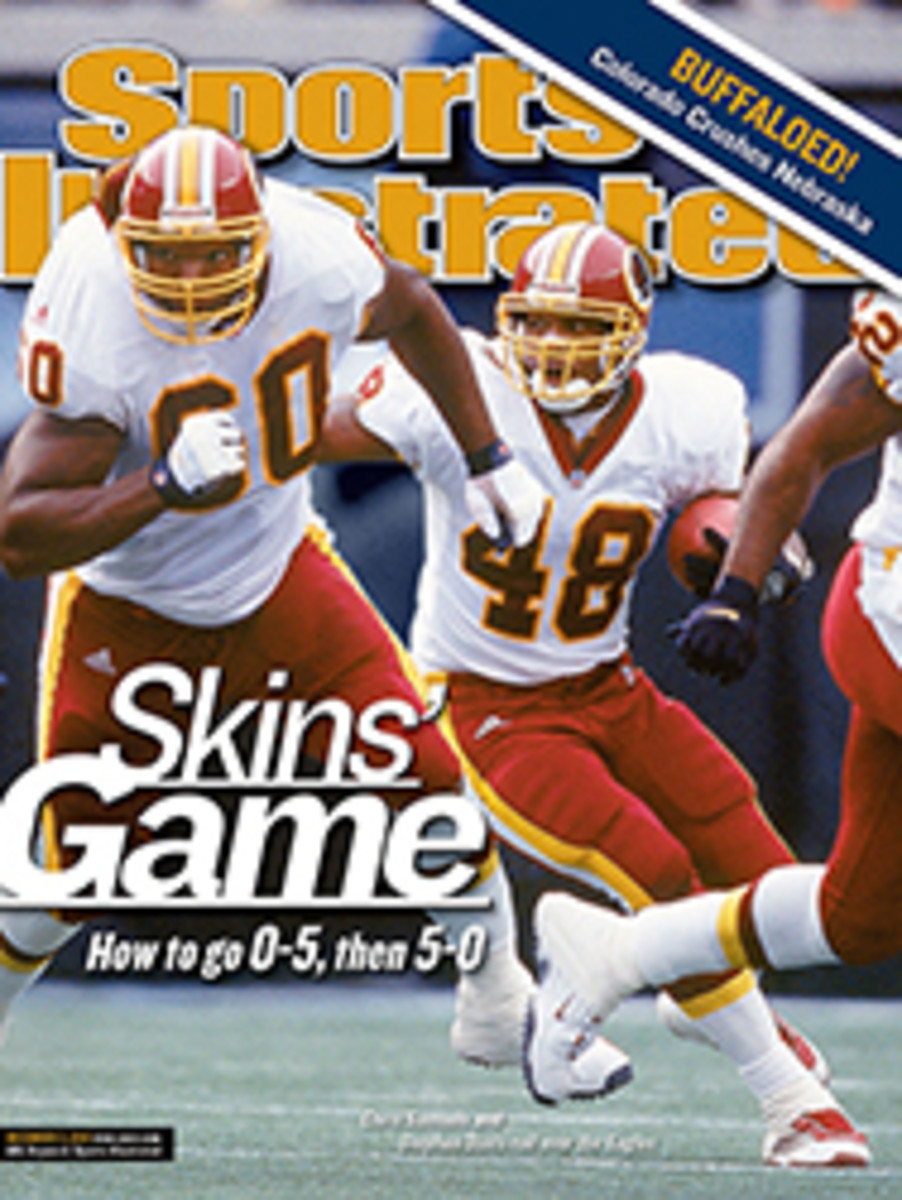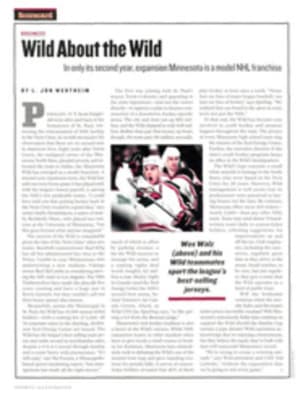
Run To Glory Onrushing Colorado scrambled the national title picture by stepping all over No. 2 Nebraska
Were you Northwestern coaches watching? Do you think Chris Brown
may have had a point, after all? You remember Brown. He
transferred out of your program early in the 1999 season, after
you insisted on switching him from running back to wide
receiver. "Didn't like the position," says Brown. "It wasn't me."
Last Friday, in the most stunning upset of the college football
season, the guy who had been told to run pass routes instead
looked a lot like a young Eric Dickerson. The 6'3", 225-pound
Brown rushed for six touchdowns in Colorado's 62-36 pasting of
second-ranked Nebraska. Brown, a sophomore, started the game as
one of the Buffaloes' backup tailbacks and finished with 198
yards on 24 carries. "He's a great kid, very strong, with great
leg drive," says Colorado coach Gary Barnett. "We were playing
Purify"--felicitously named tailback Bobby Purify also pureed
Nebraska's defense, for 154 yards--"but then Chris caught fire."
Imagine the damage he might have done as a receiver.
Forget football's insistence on dividing games into quarters.
Boulder's Folsom Field was the stage for a three-act play on
Thanksgiving Friday. Act I: Colorado bolts to a 35-3 lead in the
first 18 minutes against BCS rankings leader Nebraska. Act II:
The Cornhuskers rally behind Heisman Trophy candidate
quarterback Eric Crouch, pulling to within 42-30. Act III: Brown
breaks Nebraska's back with his fourth, fifth and sixth
touchdown runs. In deflating the Cornhuskers' national title
hopes, the Buffaloes (9-2) won the Big 12 North and advanced to
the conference championship game in Irving, Texas, on Saturday.
There Colorado will face sizzling Texas (10-1), which dominated
the Buffaloes 41-7 on Oct. 20 in Austin.
However, after Colorado blew through Nebraska, the logical
question was, How did these Buffaloes lose to anyone?
"Basically, we've beaten ourselves," says senior quarterback
Bobby Pesavento. He tossed off that response before Oklahoma
State's 16-13 upset of Oklahoma last Saturday made Texas the
South division winner and Colorado's conference title game
opponent. Had Pesavento known he'd be seeing the Longhorns
again, he might have given them more credit for their 34-point
win over the Buffaloes. The fact remains that Colorado had four
turnovers in its season-opening 24-22 loss to Fresno State and
four more against Texas.
Last Friday it was the Cornhuskers who had four giveaways,
including a back-breaking fumble at the Buffaloes' one-yard line
in the third quarter, while Colorado had none. The 62 points the
Buffaloes scored were the most ever hung on Nebraska. The proud
Blackshirts defense came into the game ranked sixth in the
nation in total defense, having yielded 93 rushing yards per
game. Colorado had 114 on its first seven carries, 382 by the
end of the game. It was the sort of onslaught--582 total yards,
8.2 yards per play--we've come to expect from, well, the
Huskers. "They haven't really had anyone line up and try to run
at them," said Barnett before the game. "Everybody has tried to
finesse them. We're not a finesse team."
The seeds of this rout were sown a year ago at Lincoln's
Memorial Stadium. Having just completed a 3-8 season (notable
for Barnett's threat to strip the Buffalo decals from his
players' helmets after Colorado had started 0-4), the players
came together in the visitors' dressing room after losing 34-32
on a last-second, 29-yard field goal. Recalls strongside tackle
Victor Rogers, "We'd lost to Nebraska the year before on a field
goal in overtime. To lose again on the last play--we thought we
were cursed. We vowed in that locker room that we'd never lose
to Nebraska again."
Eleven of this year's 27 Buffaloes seniors were recruits of Rick
Neuheisel, who left Boulder for Washington after the 1998
season. Barnett, who came to Colorado from Northwestern, didn't
find a smash-mouth team awaiting him. "Colorado hadn't been
effective at running the ball since '96," he says. "It didn't
have the mentality or the backs. We had to recruit the backs and
instill the mentality."
Consider it instilled. Visitors to the Colorado football offices
around 8:30 last Saturday morning could hear offensive
coordinator Shawn Watson shouting, "My God! Wow!" from behind
his office door. While reviewing video of Brown's second
touchdown, Watson had seen guard Andre Gurode drive a Huskers
defender clear through the end zone and pin him against the wall
beneath the seats. "Talk about finishing blocks," said Watson a
few minutes later. "Andre is a lethal weapon--the best guard
I've been around in 20 years of coaching."
The 6'4", 320-pound Gurode is the top athlete among an
exceptionally athletic group of hogs. On the weak side of the
formation is the Felix-and-Oscar guard-tackle combination of
sophomores Marwan Hage and Justin Bates. The 6'4", 295-pound
Bates is technically precise. While Hage, who stands 6'3" and
weighs 295 pounds, may be a bit more slovenly in his technique,
he makes up for it in intensity. "Marwan's a brawler," says
Watson, "a guy who's coming at you 100 miles per hour, every
snap." At center is the cerebral Wayne Lucier, a 6'4", 300-pound
junior and one of two former Northwestern players who followed
Barnett to Boulder. Watson raves about the consistency and
intellect of Lucier, who makes the line calls. Eclipsing the sun
outside Gurode, who is expected to be one of the first guards
selected in next April's NFL draft, is Rogers, a fast, agile,
6'7", 315-pound senior tackle who's excelling in his first
injury-free season.
Rogers chewed out his teammates at halftime of Colorado's Oct.
27 game against Oklahoma State, admonishing them for their
failure to "play for one another" in falling behind 16-7. The
Buffaloes rallied for a 22-19 victory, displaying a resilience
they'd lacked in Barnett's first two seasons. Instilling such
mental toughness was Barnett's goal on the eve of two-a-days in
August, when he showed his squad a scene from the 1993 film The
Fugitive. In it the U.S. marshal played by Tommy Lee Jones
pursues the fleeing Dr. Richard Kimble, played by Harrison Ford,
through a huge drainpipe. When Ford movingly protests his
innocence, Jones replies, "I don't care!"
Barnett wanted that single-mindedness from his players,
regardless of the obstacles that might come between them and
their goal: a Big 12 championship. The first speed bump arrived
earlier than expected. Trailing Fresno State 24-22 late in the
game on Aug. 26, the Buffaloes were denied a chance for a
game-winning field goal attempt when sophomore quarterback Craig
Ochs threw into double coverage and was intercepted.
While Barnett was pilloried by the Colorado media after the
loss, the seniors kept the team focused, and the Buffaloes won
nine of their next 10 games. No player has been more valuable,
since the loss to Texas, than Pesavento, the backup quarterback
who took over for the injured Ochs (strained ankle tendon)
against Oklahoma State. Pesavento has completed 57 of 83 passes
for 869 yards and six touchdowns, with two interceptions. He was
in a zone of his own in the first half against Nebraska,
completing eight of his first 11 passes for 192 yards and a
touchdown, and generally making the Blackshirts look like the
Dodge City Conquistadors of the Kansas Jayhawk Conference--the
second of three leagues in which Pesavento has labored as a
collegian. (He arrived in Boulder via Fort Scott [Kans.]
Community College, where he spent the 1999 season after
transferring from Miami of Ohio.)
The system Pesavento runs at Colorado is a variation of the West
Coast offense--short and intermediate passes based on precise
timing--tied to a power running game. The Cornhuskers, God bless
them, have been running the same 4-3 defense for the last decade
or so. With two weeks to prepare for it, Watson says he could
"lock in on some things." Adds Lucier, "Our formations were
taking their safeties out of the box. Once Chris [Brown] and
Bobby [Purify] got past the linebackers, they were running
scot-free."
Nebraska adjusted late in the second quarter--walking a
linebacker up to the line of scrimmage and using him as a fifth
lineman--and Pesavento answered by going to the air. He hit
Daniel Graham, his superb senior tight end, for a 19-yard gain
on a third-and-nine. On the next play Brown went 36 yards for
his second touchdown. He was just getting started.
After starring at Naperville (Ill.) North High, Brown followed
his brother Levelle to Northwestern. Levelle had been a fullback
for Barnett from 1995 through '98. Shortly after Chris committed
to the Wildcats, however, Barnett accepted the Colorado job; he
was replaced at Northwestern by Randy Walker, who was adamant
that Chris switch to wide receiver. It was a rocky time for
Chris, who thought seriously about quitting football. Instead he
enrolled at Fort Scott, where he racked up 1,284 yards in 10
games despite sharing playing time. "More than anything, he got
his confidence back," says Levelle, now a research analyst for a
health care consulting firm in Oakbrook, Ill. "He'd begun to
doubt himself a little at Northwestern."
Last fall Brown arrived at Colorado, began breaking off
head-turning runs in scrimmages and climbed from fifth to first
on the depth chart. "Chris can beat you up, run around you or
make you miss," says running backs coach Eric Bieniemy, the
Buffaloes' alltime leading rusher. "The more carries he gets,
the stronger he gets."
After rushing for more than 100 yards three times in Colorado's
first five games, Brown saw his carries dry up: 14 against Texas
A&M, eight against Texas, three against Oklahoma State, one
against Missouri and no touches against Iowa State. "It's not
like he was in the doghouse," Bieniemy says. "We had some pretty
fast opponents who we thought called for quicker, more elusive
guys [rather than a power back like Brown]. Of course, looking
back, we wonder, What if?"
Brown would rather have his coaches pondering that question than
wondering, as others have, What if he were a receiver?
COLOR PHOTO: PHOTOGRAPHS BY JOHN BIEVER Purify blew through holes created by the Buffaloes' ferocious forward wall to gain 154 yards on 20 carries, including this 39-yard touchdown dash.
TWO COLOR PHOTOS: PHOTOGRAPHS BY JOHN BIEVER Oh, yeah! Having helped clear the way for Brown (22) to rush for 198 yards and six touchdowns, Lucier had reason to celebrate.
COLOR PHOTO: BILL FRAKES Statuesque Brown and linemen (from left) Bates, Rogers, Hage, Lucier and Gurode were as hard as bronze.
SMELLING THE ROSES
If top-ranked Miami beats Virginia Tech on Saturday, and No. 2
Florida gets past Tennessee this weekend and either LSU or
Auburn for the SEC championship on Dec. 8, the Hurricanes and
Gators will most likely meet in the Rose Bowl national
championship game. Here's what would have to happen, though, for
four other hopefuls to end up in Pasadena on Jan. 3.
Team (record)--BCS Rank--BCS pts.--Remaining opponents
Texas (10-1)--3rd--8.77--Colorado
The Longhorns must defeat the Buffaloes in the Big 12 title game
on Saturday, hope that either Miami or Florida loses, and keep
their fingers crossed that neither Nebraska, Oregon nor
Tennessee overtakes them in the final BCS standings, released on
Dec. 9.
Nebraska (11-1)--4th--10.48--none
The Cornhuskers need two of the three teams ahead of them in the
BCS to lose, while neither Oregon nor Tennessee wins out and
leapfrogs them in the standings.
Oregon (9-1)--5th--10.87--Oregon State
The Ducks must defeat Oregon State on Saturday, have two of the
top three BCS teams lose and then have the recalculated BCS
standings break in their favor.
Tennessee (9-1)--6th--11.87--Florida, followed by LSU or
Auburn in SEC title game
The Volunteers must defeat Florida and win the SEC championship
game, while Miami loses and the BCS numbers fall their way
should Texas and Oregon win out.
"We thought we were cursed. We vowed that we would never lose to
Nebraska again."

